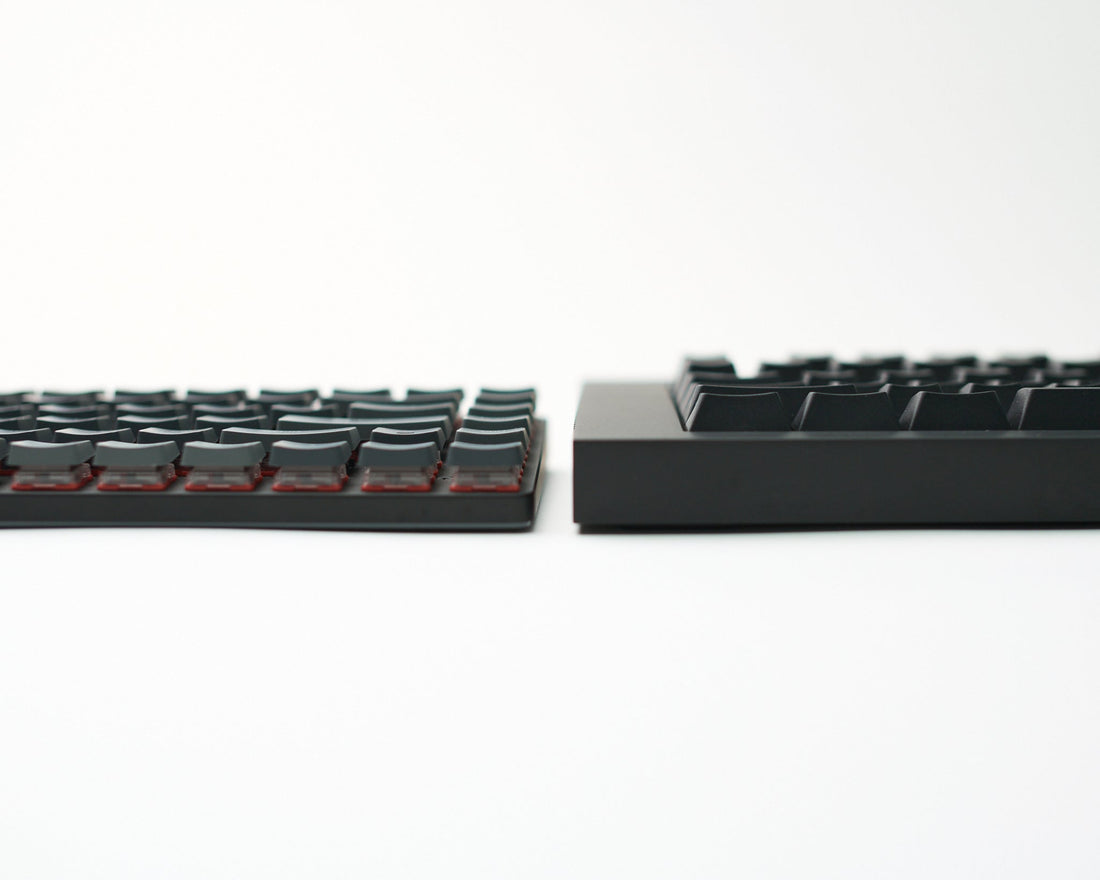
Low Profile vs High Profile Keyboards — Which Should You Choose?
When choosing a keyboard, the first thing most people notice is layout — but what really defines how it feels is the height.
Should you go for a low profile keyboard or a high profile one?
If you’re unsure what that means — or which one fits your workflow — this guide breaks it down.

What’s a Low Profile Keyboard?
Low profile keyboards are slim, minimal, and designed to sit close to the surface of your desk. They use shorter switches and flat keycaps, offering a fast, shallow typing experience.
They’re often seen as clean, portable, and convenient — great for light setups or for people coming from laptops. But they also come with some tradeoffs:
• Less cushioning or feedback per keystroke
• Limited sound profile
• Fewer customization options
They’re easy to get used to — especially if you’re just getting into mechanical keyboards — but they may not offer much beyond the basics.

What’s a High Profile Keyboard?
High profile keyboards are taller and more substantial. They use full-sized mechanical switches and keycaps, offering a deeper, more deliberate typing feel. These boards are built for comfort, feedback, and a sense of presence at your desk.
The slate75, for example, is a high profile keyboard designed not just for performance, but for experience.
It’s sculpted to give every keystroke a satisfying crispness, and every surface feels intentional — from the way it sounds to the way it sits on your desk.
With high profile boards, you’re not just typing. You’re engaging with a tool that feels meaningful.

The slate75 — A High Profile Keyboard with a Low Learning Curve
If you’ve been using a low profile keyboard and are curious about stepping up, the slate75 is designed to make that transition feel natural.
It pairs the clean aesthetic of minimal setups with the comfort and richness of a full mechanical experience.
You get:
• A zero-degree typing angle for a relaxed wrist position
• An intuitive twist-to-tilt mechanism for easy ergonomic adjustment (up to 5.5°)
• Deep, satisfying keyfeel with crisp acoustics
• A layout that feels compact but never cramped
It’s the kind of board that makes you want to type just for the joy of it.
Core Differences Between Low and High Profile Keyboards
| Feature | Low Profile | High Profile (e.g.slate75) |
| Height | Slim and flat | Taller, more sculpted |
| Typing Feel | Fast and shallow | Deep and intentional |
| Portability | Great for travel or minimal setups | More stationary, solid presence |
| Ergonomics | Naturally low hand position | Higher hand position |
| Customisation | Limited caps and switch support | Wide range of mods and tuning |
| Acoustics | Quiet and compressed | Fuller, more expressive |

Your Hands Are Biased — and That’s OK
One thing we’ve learned: what you prefer is often just what you’re used to.
If you’ve spent years typing on a slim keyboard, low profile might feel like the obvious choice. But if you try something like the slate75, it may feel strange at first — taller keys, deeper travel, more feedback.
That discomfort? Totally normal.
Give it a week.
Once your fingers adjust, many people find that high profile keyboards feel more natural, more comfortable, and more satisfying. Your fingers move with more intention. Your typing becomes more expressive. And your keyboard feels like it’s working with you — not just beneath you.
The keyboard you start with isn’t always the one you end up loving.

Which Should You Choose?
Go for Low Profile if you:
• Want something flat, light, and simple
• Type casually or on the go
• Are transitioning from laptop keyboards and prefer familiarity
Go for a High Profile Keyboard like the slate75 if you:
• Spend long hours at your desk and want comfort
• Care about feel, sound, and design
• Want a tool that elevates your workflow
• Appreciate thoughtful details and refined craft

Final Thoughts
Low profile keyboards are a great starting point — they’re easy, portable, and familiar.
But if you’re ready to turn typing into an experience, high profile keyboards offer a depth that’s hard to unfeel once you’ve tried it.
The slate75 was made for that moment — the shift from “good enough” to “this just feels right.”
It’s not just about the keys. It’s about how they make you feel while you work.
